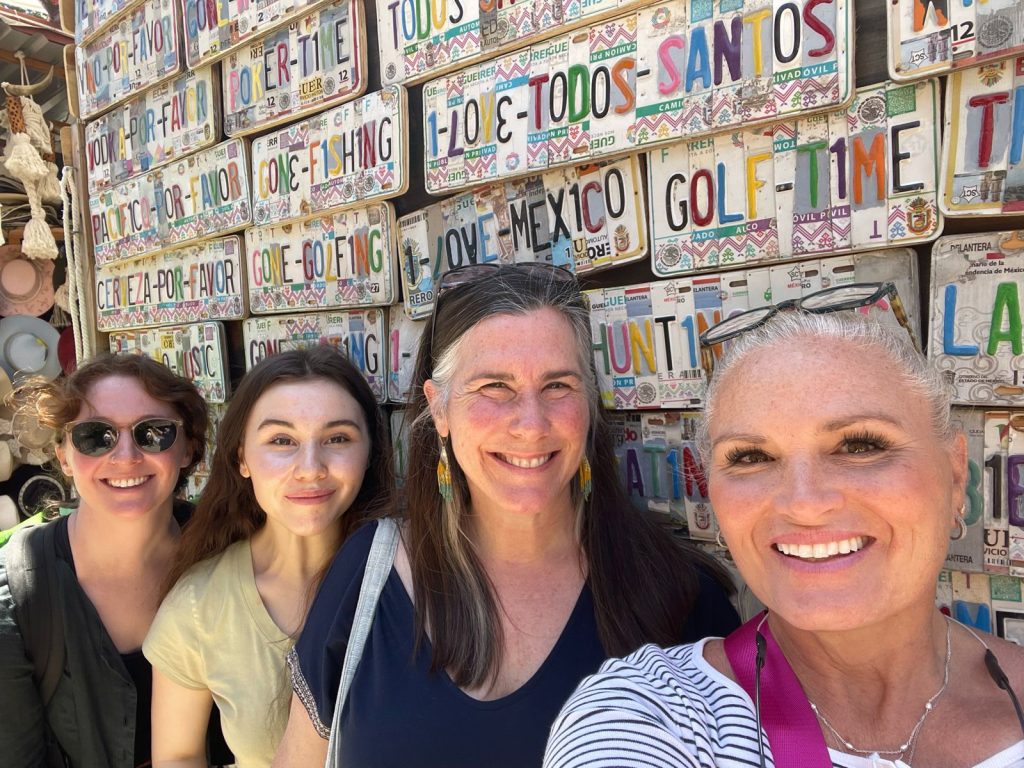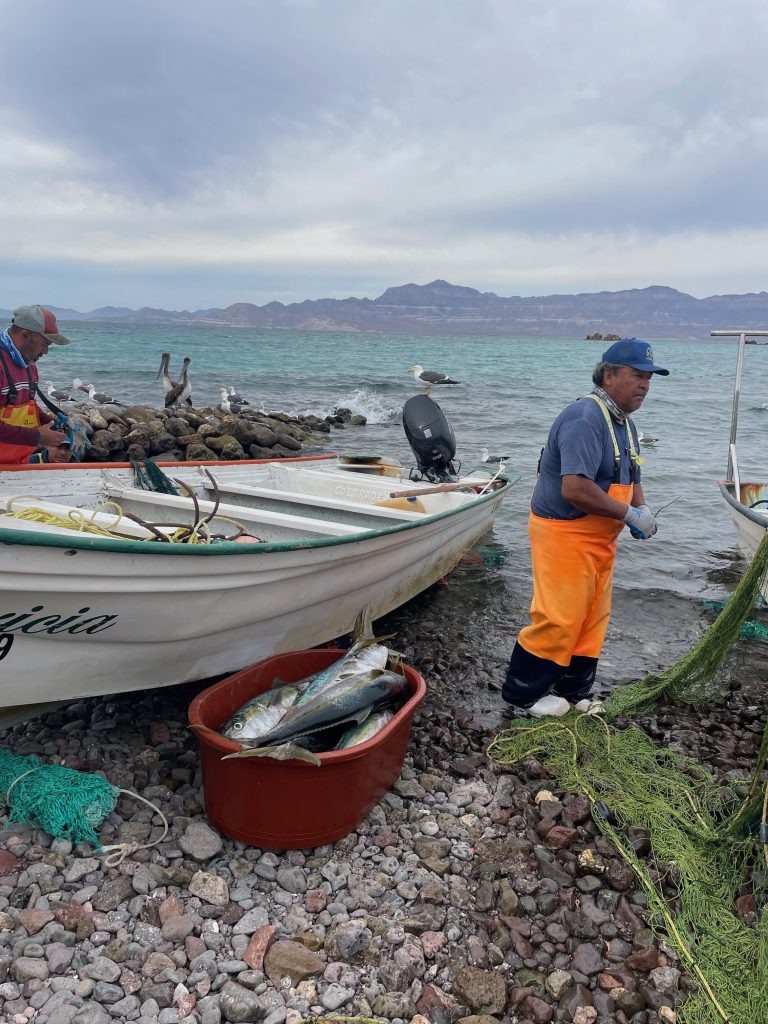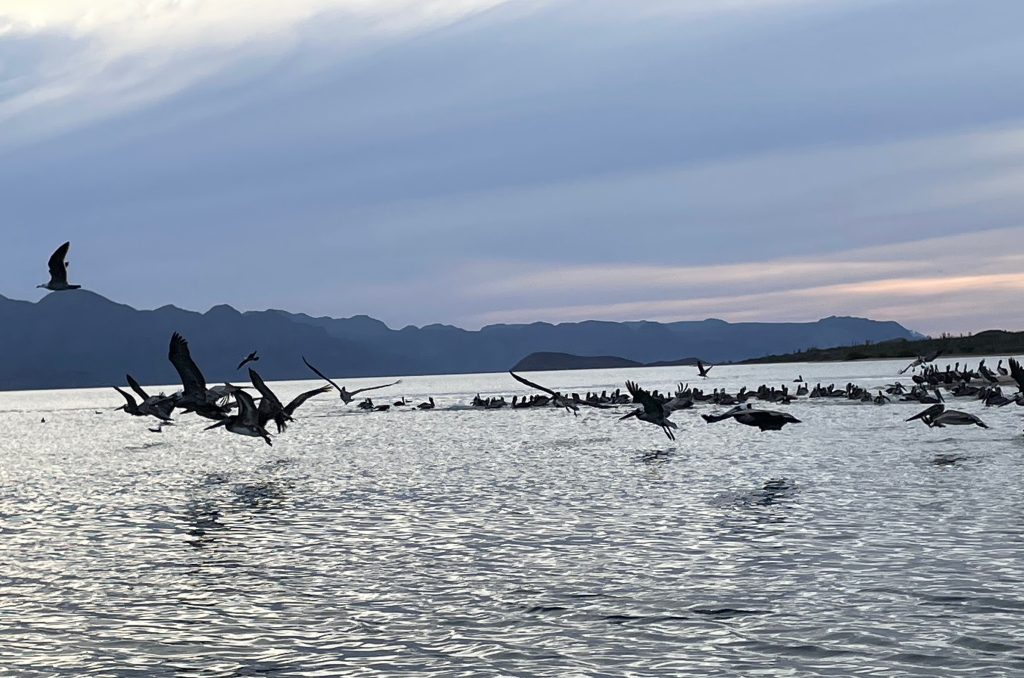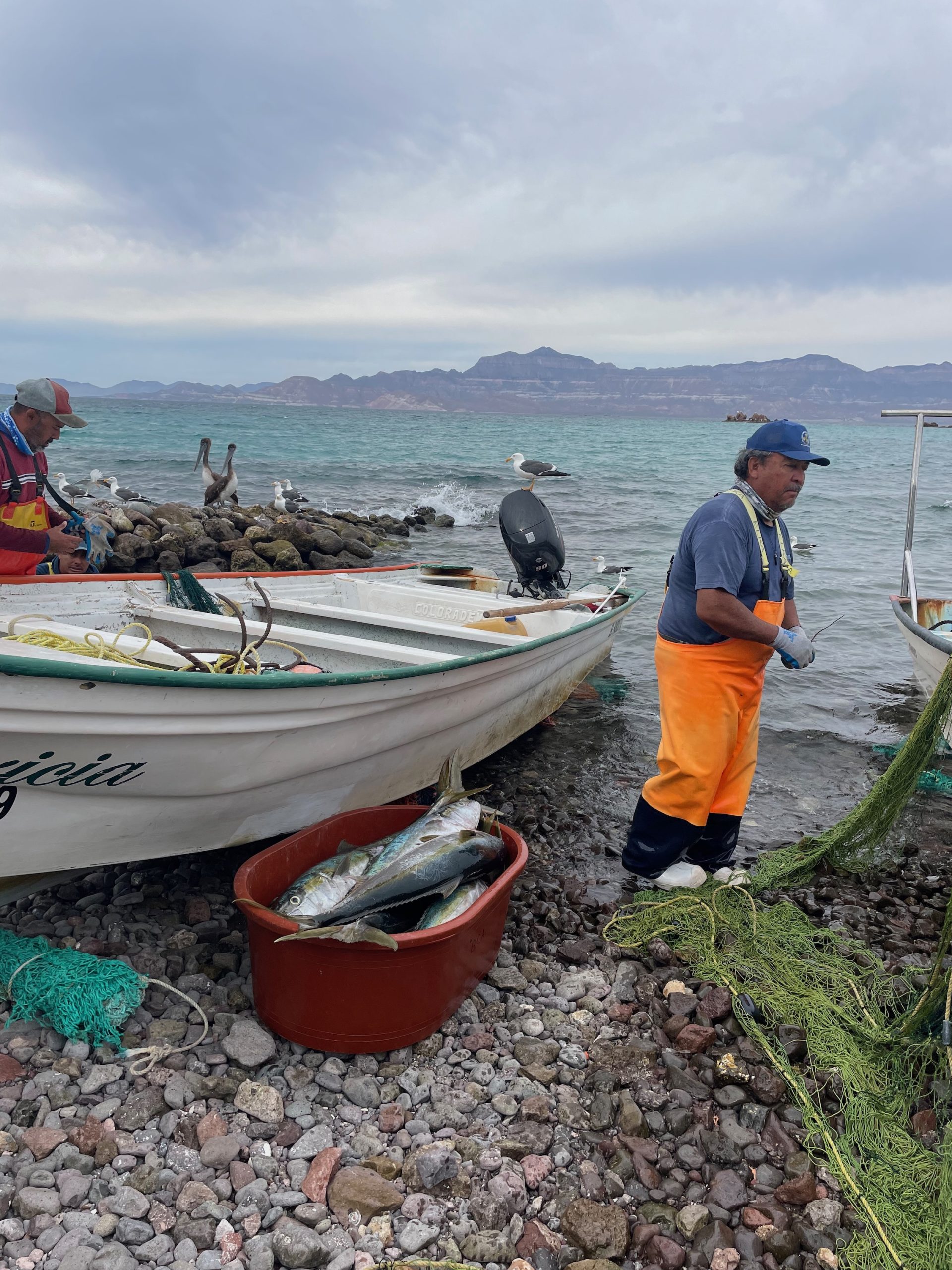
Connecting local and scientific knowledge
Earlier this spring, I traveled to La Paz, on the gulf coast of the Mexican state of Baja California Sur (BCS). It had been four years since I had last visited, in March 2020, as the pandemic was spreading across the globe.
I was grateful to be able to travel with a close colleague and friend, Hudson; my daughter, Eva; and my graduate student, Sarah. With them, I saw places I had been before with new eyes. I also was fortunate to visit some new places.
Hudson introduced us to El Pardito, a small fishing community that has engaged in a revolutionary approach to ocean management over the last 15 years. We were the guests of Doña Clara and Don Pablo and their sons, Juan and Felipe. Doña Clara cooked meals for us that included one of the fish in season, jurel or yellowtail, and she taught Eva to make tortillas to wrap around the fresh fish.
We had the chance to explore the rocky reefs surrounding the island, snorkeling. The shoreline sloped gently away from the island, providing easy entry to the sea, even with wind and waves. Broad boulders interspersed with smaller structure and some sandy areas provided homes for wide diversity of fishes, hard and soft corals, and other invertebrates.
In the afternoon, when the wind blew fiercely and the sun shone hot, we sat in the shade and talked. Hudson and Juan and Don Pablo traded fishing stories. They talked about how different species behaved, the ways that different fishes move underwater and how as fishermen, the distinctive behaviors of the fishes influenced how they found and fished for different species.
“What happened to the squid?” Juan asked. “We rarely see them now.”
Hudson replied that another member of our research team, Dr. Tim Frawley, had studied this dramatic ecosystem change, the disappearance of jumbo squid. With the decline in squid abundance, fisheries in some of the remote and rural communities of the Gulf, particularly Santa Rosalia, also were much diminished. This had happened more than once in recent memory, but after the most recent decline, corresponding with the El Niño years of 2015-16, the squid never returned, at least not in commercially viable numbers.
Hudson explained that while squid still swam in the Gulf, they were smaller than before. The environment had changed – tropical conditions dominated, which meant not only warmer ocean waters but also less food for squid and other pelagic species.1 The smaller form of squid now dominant in the Gulf ecosystem also is less catchable, at least in the ways that fishermen had caught them before.
As I listened to this conversation, I thought about the fishers’ deep and geographically specific knowledge of the habits and ecologies of so many different species. Local ecological knowledge like theirs often is not well-represented in government-led fisheries management. Fortunately, in the case of the Corridor, the geographic region within which El Pardito sits, local knowledge has been integral to recent management strategies, and specifically to the development of a series of fishery refuges that were later recognized by both the state and federal governments.2
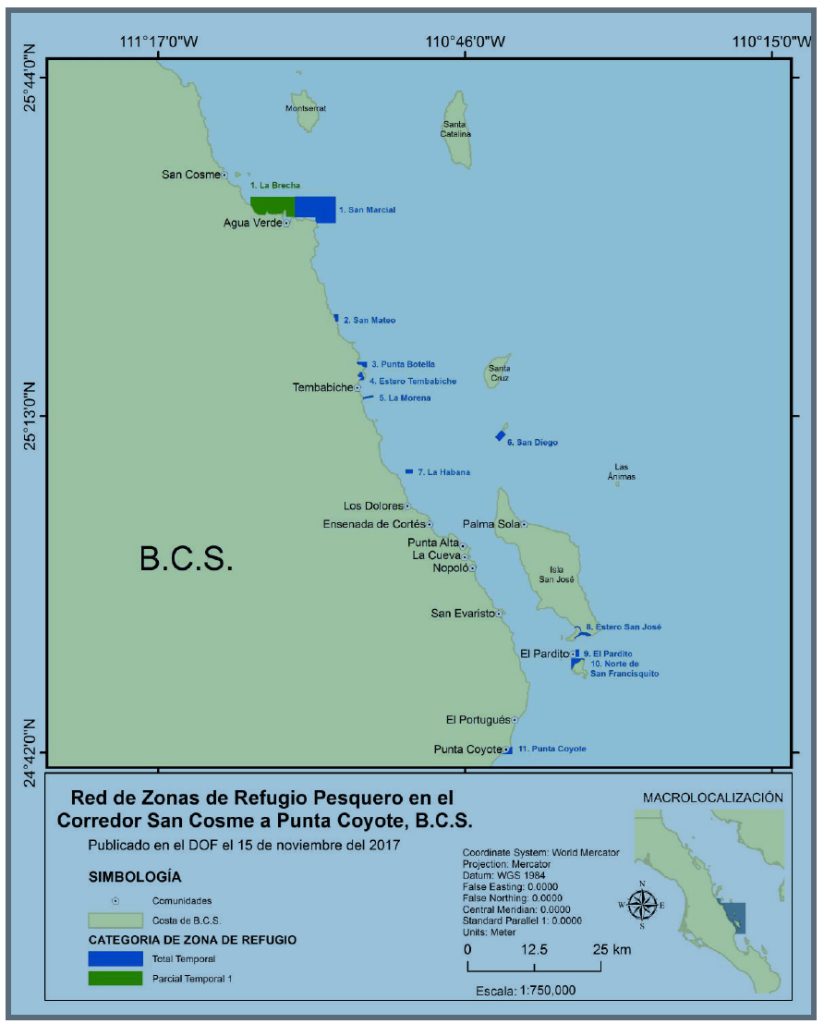
Juan and his brother are unique among fishers in the region in that they not only fish for a living, they also work with researchers, studying sharks, sea lions and some of the many other marine organisms that live in the diverse ecosystems that surround El Pardito. They showed us some of the places that are important to them – not so much for fishing but for the biological diversity that can be experienced there.
At dusk, we made our way by boat to Isla San José, a larger island just north of El Pardito. We motored through a shallow saltwater channel into the estero, or estuary, on the southwestern tip of the island, where flocks of pelicans, terns, and other seabirds fed in the shelter of a dense mangrove forest. A mangrove warbler sang nearby, bright yellow against the green leaves of the mangrove. Fish jumped on the edge of the channel, prompting the pelicans to launch back into the sky and try their luck at fishing. The brothers told the story of exploring the mangrove forest as kids, trying to make their way to an abandoned house on a high point in the desert that we could just see above the seaside forest.
The estero ended against a gravel berm, protected from the waves of the Gulf. We talked about what this place had looked like a generation ago, when the brothers first visited this spot. They described an islet open to the ocean, and how the gravel had filled in the passage through time, for reasons no one could quite explain. We could see small mangrove trees growing on the edge of the gravel bed, a sign that the forest might continue to expand in the wave-protected reaches of the estero.
Time scales of ecosystem change
This talk of ecosystem change over years – in the case of squid generations and fishing seasons – and then over decades – in the case of shoreline movement and human generations – got me thinking about time. Humans have been challenged by ecosystem changes on these time scales for a long time, much longer than people have ‘managed’ fisheries or other interactions that people have with marine species and ecosystems.
What are the time scales that we need to understand, to enable people in coastal communities like El Pardito to engage in ecosystem-based responses to climate change and other threats to people and nature?
I would say that we particularly need to understand the time scales at which people can take action strategically and collectively – several years or decades into the future. That is the scale of community planning and policymaking and also the scale at which people are thinking not only about what the future may hold for themselves, but for their children and the places and more than human world that they cherish.
Researchers have forecasted how marine species have or will respond to different climate change impacts,3,4 and how in turn fishers adapt to climate change impacts.5 This is an important area of study and requires both observations from the field as well as sophistical models of human-nature interactions. But these forecasts and retrospective studies of climate impacts, even the empirically grounded ones, can only illuminate so much. They often fall short when it comes to modeling the heterogeneity of social-ecological systems, particularly spatial heterogeneity. The diversity of ways different fishers fish in the Gulf, even for the same species;6 the variation in how different fished species respond to changing water temperature, chemistry, and currents;3 and how this variation plays out across a biophysically and socioeconomically diverse seascape5,7 challenge our science. More often than not, our results are illustrative rather than predictive.
But there’s hope – here is where linking local knowledge with the full toolkit of social-ecological system science tools, drawn from anthropology, ecology, economics, geography, oceanography, sociology, etc. – can make a difference. My conversations on El Pardito last month newly inspired me to think about how we can do this, in Mexico and in Maine.
Acknowledgements
This research was made possible by the US National Science Foundation through CNH2-S award BCS-2009821.
Related Reading
1. Frawley, T. H. et al. Impacts of a shift to a warm-water regime in the Gulf of California on jumbo squid (Dosidicus gigas). ICES J. Mar. Sci. fsz133 (2019) doi:10.1093/icesjms/fsz133.
2. Quintana, A., Basurto, X., Rodriguez Van Dyck, S. & Weaver, A. H. Political making of more-than-fishers through their involvement in ecological monitoring of protected areas. Biodivers. Conserv. 29, 3899–3923 (2020).
3. Cisneros-Mata, M. A. et al. Fisheries governance in the face of climate change: Assessment of policy reform implications for Mexican fisheries. PLOS ONE 14, e0222317 (2019).
4. Aburto-Oropeza, O., Paredes, G., Mascareñas-Osorio, I. & Sala, E. Climatic influence on reef fish recruitment and fisheries. Mar Ecol Prog Ser 410, 283–287 (2010).
5. Frawley, T. H. et al. Self-governance mediates small-scale fishing strategies, vulnerability and adaptive response. Glob. Environ. Change 84, 102805 (2024). https://doi.org/10.1016/j.gloenvcha.2024.102805
6. Pellowe, K. E. & Leslie, H. M. Heterogeneity among clam harvesters in northwest Mexico shapes individual adaptive capacity. Ecol. Soc. 24, art25 (2019). https://doi.org/10.5751/ES-11297-240425
7. Leslie, H. M. et al. Operationalizing the social-ecological systems framework to assess sustainability. Proc. Natl. Acad. Sci. 112, 5979–5984 (2015). https://doi.org/10.1073/pnas.1414640112

